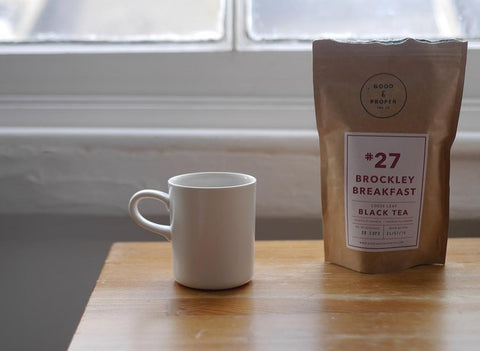What is breakfast tea?
By Emilie Holmes

Research has suggested that sales of traditional black teas are on the decline, due to the increased popularity among younger tea drinkers of greens and herbals, but that’s not to say we don’t still drink a huge volume of it. In fact 98% of the 165 million cups of tea we drink every day in the UK are still taken with milk. So what is breakfast tea anyway and why do we love it so much? Here’s the low down on Britain’s favourite brew.
What is breakfast tea?

Breakfast tea, builders tea, normal tea, bog-standard tea...we’ve had customers ask for it every which way and yet each of them want the very same thing - a cup of tea they can add milk to. That could in reality mean a rich, robust Assam, an earthy, full-bodied Kenyan or a lighter, more aromatic Ceylon - all perfectly happy with a dash of milk. However, in most cases the solution to a request for a breakfast tea will be a variation on an ‘English Breakfast’ - the world’s most famous tea blend. Combining multiple, single-origin black teas - typically Assam, Kenya and Ceylon - this popular blend brews a full-bodied cup that is perfectly suited to the addition of milk - just the way we Brits have enjoyed it for centuries.
How is breakfast tea made?

Though the individual components of a breakfast tea blend might be grown in different regions around the world, they are all black teas. That means that wherever they are grown, the leaves all come from the tea plant, Camellia Sinensis, and are fully-oxidised after picking, giving them their characteristically rich, robust flavours. You can find out more about black tea here. The particular flavour profile of any one ‘English Breakfast’ tea, from one brand to the next, will therefore depend on the particular blend of black teas and their relative quantities. Different black teas will have different flavour profiles depending on where they are grown, and each will therefore bring different characteristics to the final blend. For example, northern favourite Yorkshire Gold has a high proportion of Kenyan tea, one of the most robust black teas, in their blend, making it an altogether stronger brew. It is therefore down to the blender to decide what they hope to achieve in terms of resulting flavour, before selecting the teas they wish to combine.
How do we make our Breakfast Blend?
At Good & Proper we source single-origin teas from around the world, selecting teas that can stand up on their own without blending or flavouring. That means it is the terroir or geographical location of where it is grown, as well as the expertise of those crafting the tea, that determines the flavour of any particular one. And on top of that, as some teas are harvested just once or twice a year, those teas can differ from one year to the next. We therefore spend a lot of time tasting - new batches, new harvests, new farms - always looking for teas that best showcase the qualities of their type, all the while celebrating the nuances that each year and each harvest brings. For our first house blend we didn’t want to lose any of that, but instead hoped to combine the strengths of some of our most popular black teas into a brew that we think is even better than the sum of its parts. That blend is the now award-winning Brockley Breakfast, made up of a rich, robust Assam and Kenya base, lifted by the bright, aromatic character of a Ceylon and the fragrant notes of our Darjeeling. The result is a wonderfully balanced, all round breakfast tea, served best with a dash of milk. Oh and we named it after our South East London home Brockley, because it is hand blended here and...well because we love it here.
How best to enjoy Breakfast Tea

As you now know, breakfast teas are blended to pair well with milk as an invigorating morning brew, but we’ll happily reach for a breakfast tea pick-me-up any time of day. We brew ours in a pot with freshly drawn water, just off the boil, before pouring over a dash of semi-skimmed milk. Yep, for us it’s milk first but only when pouring from a pot. Best save that debate for another day...
Take a look at our video here for how to make loose leaf tea.

 WHOLE LEAF TEAS
WHOLE LEAF TEAS
 CAREFULLY SOURCED
CAREFULLY SOURCED
 FREE DELIVERY OVER £25
FREE DELIVERY OVER £25
 WORLDWIDE SHIPPING
WORLDWIDE SHIPPING
